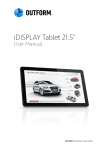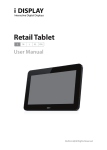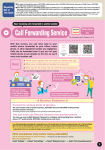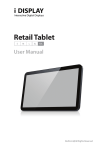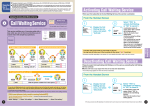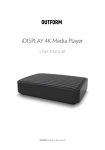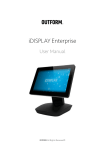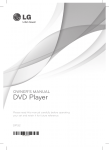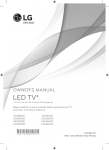Download iDISPLAY Touch Player
Transcript
iDISPLAY Touch Player User Manual About This Guide Thank you for purchasing an iDISPLAY product. We recommend reading this user guide carefully in order to achieve optimal pleasure and performance and to maximize the service life of this product. The iDISPLAY Touch Player is intended for commercial use and to be handled by authorized personnel to set up in a commercial environment. Introducing the iDISPLAY Touch Player – introduces the iDISPLAY Touch Player and components. Getting Started - describes how to set up and start the Touch Player. Playing Content – lists the various options for displaying videos, pictures and applications. Main Android OS Screen (Home Screen) – explains the Home Screen and Applications Menu, which provides access to Settings and other standard Android tools. iDISPLAY Touch Player Accessories - describes the mounting attachments and other accessories. You may also refer to http://www.outform.com/idisplay-touch-player-spec.html to download the latest version of this user guide. For support contact: [email protected] Important Notice Copyright © 2013 OUTFORM. All rights reserved. All intellectual property rights in this publication are owned by OUTFORM and protected by applicable copyright laws and international treaty provisions. OUTFORM retains all rights not expressly granted. No part of this publication may be reproduced in any form whatsoever or used to make any derivative work without prior written approval by OUTFORM. OUTFORM reserves the right to revise this publication, and/or make improvements or changes in the product(s) and/or the program(s) described in this documentation at any time without prior notice. The information in this document is provided in good faith, but without any representation or warranty whatsoever, whether it is accurate, or complete or otherwise, and on express understanding that OUTFORM shall have no liability whatsoever to other parties in any way arising from or relating to the information or its use. All other trademarks are the property of their respective owners. Other company and brand products and service names are trademarks or registered trademarks of their respective holders. This device complies with CE and FCC regulations. Index Safety and Warnings5 Introducing the iDISPLAY Touch Player 6 Getting Started9 Playing Content 12 Main Android Home Screen 18 iDISPLAY Touch Player Accessories 20 Safety and Warnings NOTE This mark is applied to indicate that the equipment conforms to all applicable FCC regulations. This mark is applied to indicate that the equipment conforms to all applicable European safety and other standards. WARNING! Main Supply: This equipment is designed to operate from a 100-240 Volt, 50/60Hz AC main supply. The use of other power sources may damage this equipment. Check that the voltage marked on the rating plate located at the rear of the power adaptor states 100-240V. The manufacturer will NOT accept responsibility for damage or injury caused by connecting to the incorrect voltage. WARNING! Main Adaptor: The supplied power adaptor is compatible with a standard A/C socket. NB. If the power adaptor or lead gets damaged, it must be replaced by a qualified service agent with an approved adaptor of the same type and rating. WARNING! Dangerous voltage constituting a risk of electric shock is present inside this equipment. WARNINGS! The mains is the primary disconnect point. Do not obstruct holes and ventilation slots. Do not expose this product to dripping or splashing or place any objects filled with liquids on or near the product. Do not place an open flame source, such as lighted candles, on or near this product. Do not attempt to repair or open this product yourself. Always use a qualified service agent to perform adjustments or repairs. 5 Introducing The iDISPLAY Touch Player This chapter introduces the Touch Player and its components. What is the iDISPLAY Touch Player? The iDISPLAY Touch Player is a solid-state, Android-based media player that is specifically designed to be used in commercial environments. It supports full HD 1080p resolution to support almost any screen size, and when it is attached to a Touch Screen Monitor, it can be used to convert it into what is effectively an AndroidOS “tablet-like” computer. The Touch Player is powered by Pulse, OUTFORM’s own technology platform that combines hardware and software to create an ideal “outof-the-box” solution for digital displays in public locations. Some of those features are: embedded Wi-Fi and optional 3G/4G/LTE, CMS-integration, auto-power on, auto-play of content (videos, picture slideshows, smart apps, etc.), auto-copy and auto-detect of peripherals, and much more. For more on the iDISPLAY Touch Player, please refer to http://www.outform.com/idisplay-touch-player.html. To learn more about Pulse Technology, please refer to http://www.outform.com/pulse.html. iDISPLAY Touch Player Components The following components are provided: iDISPLAY Touch Player Power Supply Unit USB Mouse 6 Introducing The iDISPLAY Touch Player iDISPLAY Touch Player top view 1 iDISPLAY Touch Player bottom view 2 2 iDISPLAY Touch Player front view 3 Introducing The iDISPLAY Touch Player iDISPLAY Touch Player side view 4 7 iDISPLAY Touch Player back view 5 6 7 8 9 10 11 12 13 14 8 No. Description 1. Power Indicator 2. Mounting option 3. ON / OFF Button 4. Ethernet Port 5. Reset Pin Hole 6. DC In – Power Input 7. USB Port 1 (this port can be changed from its default “Host Mode” to “Device Mode” allowing it to be connected directly to PC (or other) computer. 8. Micro SD Port for playing content 9. HDMI port for connecting the Touch Player to screen 10. Micro SIM Card Port 11. USB Port 2 12. Headphone Jack (with Audio Out and Mic In). 13. PB-Molex connector for Optional Connect Box 14. Slot for 3G/4G/LTE Wireless Data Modem Introducing The iDISPLAY Touch Player Getting Started This chapter describes how to set up and start the Media Player. Setting Up Place the Touch Player, power supply, and USB Mouse on a flat surface. You will need the following additional items (not included): A screen (monitor) with an HDMI input connector and an HDMI cable. Turning on the iDISPLAY Touch Player The iDISPLAY Touch Player is preconfigured to automatically start up when power is activated – and initiate the Autoplay feature (iDISPLAY-Player application). Please refer to ‘Logging out of the Autoplay iDISPLAY-Player’ application section, for instructions on how to access the standard Android home screen. To turn on: 1. Remove the Touch Player from the box. 2. Connect one side of the power supply to the Touch Player socket located on back of the unit. 3. Plug the power supply into a standard electrical outlet. 4. Connect an HDMI cable to the display screen you wish to connect the unit to. 5. Press the On/Off button on the Touch Player for approximately two seconds. NOTE: Each time the Touch Player is powered on it may take up to two minutes to start playing. 6. Connect the USB Mouse to the Touch Player if you wish to change/adjust the settings of the Touch Player. Once connected, you will see the cursor of the mouse on the screen. Logging Out of the Touch Player Autoplay Application The Touch Player is preconfigured to automatically start the Autoplay iDISPLAYPlayer application when turned on. The following describes how to log out of this application, to access the standard Android home screen. By default, the Touch Player is password protected. You have the option to disable/ enable the requirement to enter a password using the Enable/ Disable Password Setting in iDISPLAY-Settings in order to ensure that only authorized personnel can modify and configure it. Getting Started 9 To access the Android OS screen: 1. While content is playing, quickly press the On/Off (front) button (for one second). A password window is displayed, as shown below: 2. Click in the white field (with a USB Mouse connected) to display the virtual keyboard. 3. Type in the password. The default password is: 11223344 4. Click the Done button and then the OK button. The following window is displayed: 5. Click the Exit button to exit the Autoplay application and to display the Android OS main screen. To change the password: Click the Set New Password button to enter a new password. Enter the password twice (once in each field) and click the OK button. A success message is then displayed. Click the OK button. IMPORTANT: be careful to keep a record of your new password, otherwise you will not have future access to the Touch Player. To turn off the Touch Player: 1. While the Touch Player is playing, quickly press the On/Off button on the front of the Touch Player. If password is enabled, a password window pops up. 2. Enter the password and click the OK button. The Touch Player opens a standard Android Home Screen. 3. Press and hold the On/Off button on the front of the Touch Player for at least 12 seconds. The Touch Player will then switch off. 10 Getting Started Playing Content This section describes the various options for displaying videos, pictures and applications on the Touch Player. What Does the Touch Player Play? Standard Android applications (APK’s) using Android OS 4.X. Video Formats: MPEG1 / MPEG2 / MPEG4, Divx4 / Divx5 / Divx6, H.264, AVI Image Formats: JPG, BMP, PNG, GIF Download the latest iDISPLAY Touch Player specification sheet here: ttp://www.outform.com/idisplay-touch-player.html. How Does the Touch Player Play? The following describes the various options for displaying videos, pictures and applications (Android APK’s) on the Touch Player. Default AutoPlay – Folder 0 The Touch Player disk drive contains a Root folder that can contain sub-folders. By default, the Touch Player plays the content of a folder named 0 (number zero). This folder is located in the SDCard folder (/SDcard/0). If Folder 0 contains multiple content files, then each is played in a loop (in alphabetical order). This provides control over the sequence in which the content files are played back. Video files - Played seamlessly in a loop. Image files - Each one is displayed for three seconds (default). However, the duration can be changed using the iDISPLAY-Settings application. Applications - Instead of Media Files (videos and image files), a single application (APK) can also be placed in Folder 0. In this case, the application in Folder 0 will automatically play when the Touch Player is powered on and remain on the screen. In Standby mode, it will continue running until there has been no user interaction for over 3 minutes. When you place an application in Folder 0, it should be the only file in that folder. Playing Content 11 Order of playing Loop Example: if a folder contains an image file and two video files in the following (alphabetical) order: • car.jpg • discount.mpeg • top.mpeg The Touch Player will first display the car.jpg image for three seconds (default), and then play the discount.mpeg video, followed by the top.mpeg video. While the Touch Player is playing, it will display all the content in Folder 0 repeatedly in an endless loop. Playing Content from Folders 1 – 12 using the Optional Connect Box The Touch Player can also play content from folders named from 1 to 12 and MS (Motion Sensor) if an optional Connect Box is connected. The optional Connect Box has 12 connectors for Push Buttons or Touch Sensors and 1 connector for a Motion Sensor. The Touch Player plays the content of Folder 0 by default. If one of the Connect Box Buttons is pressed, then the Touch Player plays that numbered folder once, and then goes back to playing the content from Folder 0 repeatedly. For example: When button number 6 is pressed on the Connect Box, then the content being played from Folder 0 is interrupted and the content in Folder 6 is played once. Then the Touch Player goes to back to playing the content in Folder 0 (in an endless loop). Motion Sensor The Touch Player can also support a Motion Sensor which can be attached to the optional Connect Box accessory through the special connector on the back. The motion sensor enables the iDISPLAY Touch Player to play the content of another folder in the root directory, named MS (/SDcard/MS), as follows: This option enables you to set up the Touch Player so that by default it plays the contents of Folder 0 until the sensor detects motion. When motion is detected, the Touch Player automatically starts playing the content of the MS folder. This is often used to play an “attract loop” (folder 0 content) and then play a more targeted/ specific content loop (folder MS content) when motion is sensed. The content in the MS folder is played repeatedly as long as motion is detected. When motion is no longer detected, the Touch Player goes back to playing the content of Folder 0 repeatedly. 12 Playing Content Barcode Reader – Plays Per Barcode The Touch Player can be used to automatically play the content of a specific file in the Root directory when a barcode reader is connected. Copy a file onto the Touch Player with the same exact name as the barcode. The player will then automatically play the content of that file when a product with that barcode is read. For example, if the barcode of a product is 12345678, then a file named 12345678 can be placed in the Root folder of the Touch Player. It will then play the file named 12345678 when the barcode reader scans the product barcode 12345678. USB – Loading Content Loading Content into Folder 0 To load Content from a USB memory stick into Folder 0: 1. Attach a USB mouse to the Touch Player. 2. Create a folder named 0 in the root directory of a USB memory stick. Remove all other content from the USB drive. 3. When content is playing (video, Image, Application), insert the USB drive into one of the two USB ports on the back of the Touch Player. After ten seconds, quickly press the On/Off button on the front of the Touch Player. After a few seconds a window pops up requesting a password. 4. Enter the password and Click the OK button. If this is the first time you are using the iDISPLAY Touch Player, then the password is: 11223344. The following window is displayed: 5. A) Click the “Delete Old Content” button to delete the content of Folder 0 on the Touch Player and replace it with the content of Folder 0 on the USB memory stick. – OR – B) Click the “Keep Old Content” button to add the content of Folder 0 on the USB memory stick to the content of Folder 0 on the Media Player. After copying is Playing Content 13 completed you will be notified that you can now safely remove the USB memory stick. After this the file(s) in Folder 0 will automatically start playing. If multiple files are in Folder 0, they will play repeatedly after one another. NOTE: If the Touch Player does not start to play the content, then restart it and the content should start playing automatically after restart. IMPORTANT: Do not turn off the Touch Player or remove the USB memory stick while it is copying. We recommend removing the USB memory stick after its content has been successfully copied. Loading Content into Other Folders The ES File Explorer Application is pre-installed on the Touch Player. You can use this application to copy folders/files to the player. For example, into the Folders 1 through 12, the MS folder, etc. Loading an Application The ES File Explorer can also be used to install an application. For example if the application (apk) is stored on a USB stick, you can simply locate it on the USB stick and then click on it once. ES Explorer will then copy the application to the Touch Player and install it. A shortcut to the apk will then appear on the Android Applications screen. Micro SD – Playing Content A Micro SD card can also be used to play content on the Touch Player (instead of playing the content contained in the folder 0 in the Touch Player’s internal memory). When you install a Micro SD Card which contains a folder 0, the Touch Player will automatically start repeatedly playing the content in folder 0 of the Micro SD card. This procedure does not affect the contents already in Folder 0 on the Touch Player’s internal memory, meaning that when you remove the Micro SD card, the player will go back to playing the content in Folder 0 on the internal flash memory. NOTE: You must leave the Micro SD card inserted in the Touch Player as long as it is playing. NOTE: This feature is also useful if “bad content” or a “bad app” (anything that may crash or destabilize the Touch Player) is installed in folder 0 on the Touch Player’s internal memory. To uninstall the corrupt files, simply insert a micro SD card with an empty folder 0 on it. As the content in the micro SD card will take priority over the content in folder 0 of the Touch Player’s memory, it will prevent the latter content to be played. This in turn allows you to use ES Filer Explorer to delete or replace the “bad content” in folder 0 in the Touch Player’s internal memory. 14 Playing Content Browser and Market – Downloading Content You can also download content using Wi–Fi (or the optional 3G/4G/LTE Cellular Data modem) to the Root folder of the Touch Player and then move the content to Folder 0 (or Folders 1 through 12) using the ES File Explorer application , which can be accessed from the Android Applications Menu (this is found on the upper right hand side of the screen – the icon is a little block of white squares). To use the Browser and the Google Play Store you must connect a USB Mouse to the USB ports on the back of the Touch Player, or touch the screen if the Touch Player is connected to a Touch Screen. Transferring Content directly from a PC (or other) computer The USB1 port (closest to the DC-In Power Jack) can also be also be configured to from its default “Host Mode” to “Device Mode” using iDisplay-Settings or the “USB Debug Mode” under “Developer Options” in the Android Settings app. When changed to “Device Mode”, the USB1 port can be connected to a PC (or other) computer with a standard USB cable and the Touch Player’s files system can be “seen” and accessed on the connected computer. Playing Content 15 Main Android Home Screen Browser and Search Bar Applications Menu Home Screen The Home screen provides the following options: Browser: Click to open a standard web browser in which you can access the Internet and surf the web. Applications Menu (see image above): Click to display the Applications Menu which enables access to the applications and tools installed on the Touch Player. You may refer to the Applications Menu section below for more information. Applications Menu The Touch Player provides a standard Android Application Menu which enables access to the applications and tools installed on the Touch Player. The following describes some of the applications that are especially relevant to the Touch Player. Settings: Click to configure Touch Player settings, such as Wi-Fi, Sound and so on. More information about the relevant settings options is provided in the Settings section. iDISPLAY-Player: Click to return to playing the content of Folder 0 in a loop. ES File Explorer: Click to open a file explorer window which you can use to transfer files to/from the Touch Player. This option is especially useful for transferring files downloaded from the Internet to Folder 0. Google Play Store: Google’s Play Store is an online software store developed by Google for Android applications. You can use it to download applications to the Touch Player. 16 Main Android Home Screen Settings Click the Settings button to configure typical Android setting options. Take note of the following options that are particularly relevant for the Touch Player. Setting Up Wireless Networks You can click the Settings Wireless & networks option to configure Wi-Fi and Mobile networks settings in order to download content to the Touch Player. Display Volume Use the Settings --> Display --> Volume option which can be accessed from the Android OS screen. HDMI Overscan Settings (adjusting picture size on connected display) In general the Touch Player will auto-sense the resolution and screen size of a connected HDMI monitor. However in some cases (like some TV sets with HDMI inputs), the picture size is sometimes larger than the viewable area of the display (this is often called “overscan”). The size of the picture can be adjusted in the Android-Settings applications as follows: - Connect a USB mouse - Click on the Android Settings app. - Click on the Display Option - Click on the three vertical dots shown on the top left corner on the screen (standard Android Options menu indicator). NOTE: This may be hidden from sight due to the “overscan” problem one is trying to fix, so you may have to look for it with the mouse by clicking repeatedly outside of the visible part of the screen. - Click on the “Advanced Display” option that appears. - Adjust the vertical and horizontal sliders that are shown to adjust the picture size. - This menu also allows the output HDMI resolution to be changed from 1080P to 720P is necessary. Main Android Home Screen 17 Touch Player Accessories This chapter describes the mounting attachments and other accessories that can be connected to the iDISPLAY Touch Player. Touch Screen The Touch Player can be connected to a single or multi-touch screen that supports standard Android OS 4.X drivers. This enables the connection of a Touch Player to a touch screen to deliver an interactive experience that can be used by applications (apks) in the same way as an Android Tablet. Printer The Touch Player supports standard Android OS 4.X printer drivers. This enables the connection of a printer that can be used together with applications (apks) that you load, such as coupon printer. Barcode Reader The Touch Player can be used with barcode readers that support standard Android OS 4.X drivers to automatically play the content of a specific folder by connecting a barcode reader, as described on page 13. Connect Box and Buttons The Touch Player can be connected to a Connect Box that has 12 push buttons or touch sensors. It will then play the relevant folder according to which button is pressed, as described in the Connect Box – Selecting Folders 1 – 12 section on page 12. This Connect Box can also have one motion sensor which enables the display of a folder named MS when motion is detected, as described on page 12. 18 iDISPLAY Touch Player Accessories 19 For further information or support, please contact: [email protected]




















